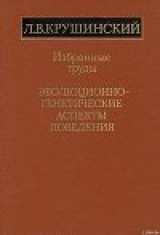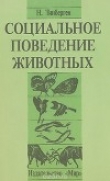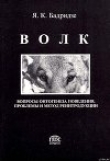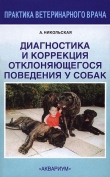
Текст книги "Эволюционно-генетические аспекты поведения: избранные труды"
Автор книги: Леонид Крушинский
Жанры:
Биология
,сообщить о нарушении
Текущая страница: 24 (всего у книги 24 страниц)
Cole L. S., Ibsen H. L. Inheritance of Congenital Palsy in Guinea Pigs // Amer. Natur. 1920. Vol. 54. P. 130–151.
Collins R. L. A new genetic locus mapped from behavioural variation in mice: Audiogenic seizure prone (asp) // Behav. Genet. 1970. Vol. 1. P. 99–109.
Collins R. L., Fuller J. L. Audiogenic seizure prone (asp) a gene affecting behavior in linkage group VIII of the mouse // Science. 1968. Vol. 162. P. 1137–1139.
Craig IV. Appetites and aversions as constituents of instincts // Biol. Bull. 1918. Vol. 34. P. 91.
Craig W. The song of the Wood pewee (Myochanes virens L.) // A study of bird music. N.Y.: State Mus., 1943. 55 p. (State Mus. Bull.; № 334).
Davis M. Imitation: A review and critique // Perspectives in ethology / Ed. P. P. G. Bateson, P. H. Klopfer. L.: Plenum press, 1973. P. 342–372.
Dawson W. M. Inheritance of wildness and tameness in mice // Genetics. 1932. Vol. 17, № 3. P. 296–326.
Digler W. C. Excepts from the comparative ethology of the african parrot genus Agapornis // Reading in animal behaviour. N. Y.; L.: Winston, 1965. P. 511–531.
Donaldson H. H. The rat. Philadelphia: Mem. Wist. Inst. 1924. 526 p.
Dravid A. R., Himwich W. A., Daiis I. M. Some free amino acids in dog brain during development // I. Neurochem. 1965. № 12. P. 901–906.
Eibl-Eibesfeldt I. Angeborenes und Erwerbenes in Verhalten einiger Stinger // Ztschr. Ti-erpsychol. 1963. Bd. 20, H. 6. S. 705–754.
Eibl-Eibesfeldt I. Grundriss der vergleichenden Verhaltensforschung. Miinchen: Piper, 1967. 528 S.
Erhardt K. Beitrage zur Hypophysen vor der Lappenreaktion unter besonderer Beriicksichtung der Ascheim-Zondekschen Schwangers schaftsreaktion // Klin. Wochenschr. 1929. – Bd. 44. S. 39.
Fox M. D. Overview and critique of stages and perioda in canine development // Develop. Psychobiol. 1971. Vol. 4 (1). P. 37–54.
Fox M. W. Behaviour in wolfs, dogs and related canids. L.: Cape, 1971. 214 p.
Fox M. W., Spencer J. Development of exploratory behaviour in the dog: Age or experience dependent //Develop. Psychobiol. 1969. Vol. 2. P. 68–74.
Frank D. The genetic basis of evolutionary changes in behavioural patterns // The genetics of behaviour / Ed. J. H. F. van Abeelen. Amsterdam: North-Holland, 1974. P. 119–140.
Fuller J. L., Thompson W. R. Behaviour genetics. N. Y.; L.; Sydney: McGraw-Hill, 1960. 240 p.
Goldschmidt R. Physiological genetics. N. Y.: McGrow-Hill, 1938.
Gottlieb G. Ontogenesis of sensory function in bird and mammals // The biopsychology of development / Ed. E. Tobach, L. R. Aronson, E. Shaw. N. Y.; L.: Acad, press, 1971. P. 67–128.
Gramef P. Recherches acoustiques sur les Corbeaux // Nature. 1959. № 3286.
Haecker V. Entwicklungsgeschichtliche Eigenschaftsanalyse: (Phanogenetik). Jena: Fischer, 1918. 344 S.
Haecker V. Aufgaben und Ergebnisse der Phanogenetik // Genet. Bull. 1925. Bd. 1. S. 20–27.
Hamburger V. Development of embryonic motility // The biopsychology of development / Ed. E. Tobach, L. R. Aronson, E. Shaw. N. Y.; L.: Acad, press, 1971. P. 45–66.
Hartley P. H. T. An experimental analysis of interspecific recognition // Symp. Soc. Exp. Biol. 1950. Vol. 4. P. 313–327.
Hebb D. O. The organization of behaviour. N. Y.: Wiley, 1949. 335 p.
Heinroth O., Heinroth M. Die Vogel Mitteleuropas. B., 1924–1933.
Heinroth O. Reflektorische Bewegungen bei Vogeln // J. Ornithol. 1918. Bd. 66, № 1/2. S. 39–49.
Heinroth O. Aus dem Leben der Vogel. B.: Springer, 1938.
Henderson N. D. Genetics influences on the behaviour of mice be obscured by laboratory rearing // J. Comp. Physiol. Psychol. 1970. Vol. 72, № 3. P. 505–511.
Henderson N. D. Brain weight changes resulting from enriched rearing condition a diallel analysis // Develop. Psychobiol. 1973. Vol. 6, № 4. P. 367–376.
Herrick C. J. Neurological foundations of animal behaviour / Ed. C. Judson Herruck. N. Y.: Hoist, 1924. 334 p.
Hess E. H. Imprinting, an effect of early experience // Science. 1959. Vol. 130. P. 133–141.
Hinde R. A. Alternative motor patterns in chaffinch song // Anim. Behav. 1958. Vol. 6, № 3/4. P. 211–218.
Hinde R. A. Animal behavior: A synthesis of ethology and comparative psychology. 2nd ed. L.: McGraw-Hill, 1970. 876 p.
Hirsch J. Behavior-genetic analysis. N. Y.; Sydney: McGraw-Hill, 1967. 522 p.
Hoffmann F. B. Die Lehre vom Raumsinn des Auges. B.: Springer, 1925.
Hoist E., Saint Paul U. Vom Wirkungsgefilge der Triebe // Naturwissenschaften. 1960. Bd. 47, H. 18. S. 409–422.
Hotta Y., Benzer S. Genetic dissection of the Drosophila nervous system by means of mosaics // Proc. Nat. Acad. Sci. USA. 1970. Vol. 67. P. 1156–1163.
Hubel D. N., Wiesel T. N. Receptive field studies in the visual system of new-born and monocularly deprived kittens // Acta psychol. 1964. Vol. 23. P. 304–305.
Humphrey E. S. I. Hered. 1934. Vol. 25, № 3.
Huxley J. S. Evolution. The modern synthesis / Ed. J. Huxley. N. Y.; L.: Harper, 1942. 645 p.
Ikeda K., Kaplan W. Patterned neural activity of a mutant Drosophilla melanogaster // Proc. Nat. Acad. Sci. USA. 1970a. Vol. 66, № 3. P. 767–773.
Ikeda K., Kaplan W. Unilaterally patterned neural activity of gynandromorphs, mosaic for neurological mutant of Drosophila melanogaster // Ibid. 1970b. Vol. 67, № 3. P. 1480–1487.
James W. T. Morphological form and its relation to behaviour. Section IV // Amer. Anat. Mem. 1941. Vol. 19. P. 525–643.
Kaspari E. Differentiation and pattern formation in the development of behaviour // The biopsychology of development / Ed. E. Tobach, L. R. Aronson, E. Shaw. N. Y.; L.: Acad. press, 1971. P. 3–15.
Keeler C., King H. D. Multiple effects of coat colar genes in the norway rat, with special reference to temperament // J. Comp. Psychol. 1942. Vol. 34. № 2. P. 24–250.
Koehler O. «Zahlende» Vogel und vorsprachliches Denken // Zool. Suppl. 1949. Vol. 13. P. 129–238.
Koehler O. Die Beziehund Mensch-Tier // Verh. Schweiz. Naturforsch. Ges. Kanton Aargau. 1960. Bd. 3. S. 44–57.
Kbhler W. Intelligenzpriifungen an Menschenaffen. B.: Springer, 1921.
Konopka R., Benzer S. Clock mutants of Drosophila melanogaster // Proc. Nat. Acad. Sci. USA. 1971. Vol. 68, № 9. P. 2112–2116.
Kramer G., St. Paul. V. yon. Uber angeborenes und erworbenes Feinderkennen beim Gimpel (Pyrrhula purrhula) // Behaviour. 1951. Vol. 3, № 4. P. 243–251.
Krushinskii L. V. Problems of comparative psychology. Comparative psychology at issue // Ann. N. Y. Acad. Sci. 1973. Vol. 223. P. 77–83.
Kung C. Genetic dissection on the excitable membrane of Paramecium // Symp. Behav. Genet. XIII Intern. Congr. Genet. 1975. P. 423–431.
Kuo Z. Y. Ontogeny of embrionic behaviour in Aves. III. The structural and environmental factors in embrionic behaviour // J. Comp. Psychol. 1932. Vol. 13, № 2. P. 245–272.
Lashley K. Experimental analysis of instinctive behaviour // Psychol. Rev. 1938. Vol. 45, № 6. P. 445–471.
Le'hrman D. S. Interaction of hormonal and experiential influences on development of behaviour // J. Ornithol. 1935. Vol. 83. P. 319.
Leopold A. S. The nature of heritable wildness in turkeys // Condor. 1944. Vol. 46, № 4, P. 133–197.
Lipsitt L. Learning capacities of the human infant // Brain and early behaviour / Ed. R. J. Robinson. L.; N. Y.: Acad, press, 1969. P. 227–249.
Lorenz K. Der Kumpan in der Umwelt des Vogels // J. Ornithol. 1935. Bd. 83. S. 137–413.
Lorenz K. Uber die Bildung des Instinktbegriffes // Naturwissenschaften. 1937. Bd. 25. S. 289–300, 307–318, 325–331.
Lorenz K. Uber die Bildung des Instinktbegriffes // Ibid. 1937. Bd. 25, H. 19. S. 289–300; H. 20. S. 307–318; H. 21. S. 325–331.
Lorenz K. Vergleichende Verhaltensforschung // Verh. Dt. Zool. Ges. 1939. Bd. 41. S. 69–102.
Lorenz K. The comparative method in studing innate behavior // Symp. Soc. Exp. Biol. 1950. Vol. 4. P. 221–268.
Lorenz K. The objectivistic theory of instinct // L'instinct dans le comportement des animaux et de l'homme. P., 1956.
Lorenz K. Evolution and modification of behaviour. Chicago; L.: Univ. Chicago press, 1965. 121 p.
Lorenz K. On aggression. N. Y.: Harcourt, Brace and Word, 1966. 306 p.
Mandel P., Rein H., Harth-Edel S., Mandel R. Distribution and metabolism of ribonucleic acid in the vertebrate C. N. S. // Comparative neurochemistry / Ed. D. Richter. N. Y.: Pergamon press, 1962. P. 149–163.
Marchlevski T. Genetic studies on the domestic dog // Bull, intern. Acad. Polon. sci. et lett. Cracovie. B., 1930. Vol. 2. P. 117–145.
Marler P., Mundinger P. Vocal learning in birds // Ontogeny of vertebrate behaviour / Ed. H. Malts. N. Y.; L.: Acad, press, 1971. P. 389–450.
Matthews S. A studing of the chronometer factor in bird navigation // I. Exp. Biol. 1955. Vol. 32. P. 39–58.
McClearn G. E., de Fries J. C. Introduction to behavioural genetics. San Francisco: Freeman, 1973. 349 p.
Mech D. L. The wolf. The ecology and behaviour of an endemgered species. N. Y.: Natural Hist, press, 1970. 834 p.
Noble C. K., Curtis B. The social behavior of the jewel fish. Hemichrhomis bimaculatus Gill // Bull. Amer. Mus. Natur. Hist. 1939. Vol. 76. P. 1–46.
Papousek H. Individual variability in learning in human infant // Brain and early behaviour / Ed. R. J. Robinson. L.; N. Y.: Acad, press, 1969. P. 251–266.
Pawlowski A., Scott J. P. Hereditary differences in the development of dominance in litters of puppies // J. Comp. Physiol. 1956. Vol. 49, № 4. P. 353–358.
Penfield W. Epileptic automatism and the centrocephalic integrating system // J. Res. Nerv. Ment. Die. Proc. 1950. Vol. 1, № 30. P. 513–528.
Penfield W. Speech, perception and uncommited cortex // Brain and conscious experience / Ed. H. C. Eccles. B.; Heidelberg; N. Y.: Springer, 1966. 369 p.
Phillips J. C. Note on wildness in ducklings // J. Amer. Behav. 1912. Vol. 2. P. 365–366.
Powel E. W. Limbic projection to the thalamus // Exp. Brain Res. 1973. Vol. 17. P. 304–401.
Rensch B. Evolution above the species level. Columbia: Univ. press, 1960. 540 p.
Riddle O. Factors in the development of sex and secondary sexual characteristics // Psychol. Rev. 1931. Vol. 38, № 11. P. 63–106.
Riddle O. Aspect and implication of the hormonal control of the maternal instinct // Proc. Amer. Philos. Soc. 1935. Vol. 75, № 6. P. 521–525.
Rundquist E. Inheritance of spontaneous activity in rats // J. Comp. Psychol. 1933. Vol. 16, P. 415–438.
Scherrer J. Electrophysiological aspects of cortical development // Progr. Brain Res. 1968. Vol. 22. P. 480–489.
Schmidt B. Zur Psychologie hundeartiger-Tiere // Natur und Volk. 1940. Bd. 70, № 6. S. 279–292.
Scott W. E. D. An account of some experiments in rearing wild finches by foster parent birds // Science. 1904. Vol. 19, № 473. P. 495.
Scott J. P., Fuller J. L. Genetics and social behaviour of the dog. Chicago; L.: Univ. Chicago press, 1965. 349 p.
Sherrington C. S. The integrative action of the nervous system. L.: Constable, 1947. 454 p. (Siliman Mem. Lect.).
Sidman R., Green M., Appeln S. The cataloge of neurological mutants of the mice. Cambridge: Univ. press, 1965. 360 p.
Thome F. C. The inheritance of shiness in dogs // J. Genet. Psychol. 1944. Vol. 65. P. 275–279.
Thorpe W. H. The process of song-learning in the chaffinch as studied by means of the sound spectrograph // Nature. 1954. Vol. 173. P. 465–469.
Thorpe W. H. Learning and instinct in animals. 2nd ed. L.: Methuen, 1958.
Tinbergen N. An objectivistic study of innate behaviour of animals // Bibl. biotheot. 1942. Vol. 1. P. 40–98.
Tinbergen N. The hierarchial organization of nervous mechanisms underlying instinctive behaviour // Symp. Soc. Exp. Biol. 1950. Vol. 4. P. 305–312.
Tinbergen N. The study of instinct. Oxford: Clarendon press, 1951. 228 p.
Tolman B. C. Inheritance of maze-learning ability in rats // J. Cop. Psychol. 1924. Vol. 4, № 1. P. 1–18.
Trimble H. C., Keeler C. E. Preference of dalmation dogs for particular position in coach running and inheritance of this character // Nature. 1939. Vol. 7, № 4. P. 671–672.
Utsurikawa W. A. Temperamental differences between outbred and inbred strains in albino rat // J. Anim. Behav. 1917. Vol. 7. P. 111–128.
Vicari E. M. Mode of inheritance of reaction time and degrees of learning in mice // J. Exp. Zool. 1929. Vol. 54, № 1. P. 31–88.
Volohoi A. A. Comparative studies of the functional development of analyser systems in animals in the process of ontogenesis // Progr. Brain Res. 1968. Vol. 22. P. 527–540.
Weisner B. P., Sheard N. M. Maternal behaviour in rats. L.: Oliver and Royd, 1933.
Whiting P. W. Reproductive reactions of sex mosaics of a parasitics wasp Habrobracon juglandis // J. Comp. Psychol. 1932. Vol. 24. P. 345–363.
Whitman C. O. Animal behaviour // Biological lectures. Woods Hole: Mar. Biol. Lab., 1899. P. 285–338.
Whitney L. F. Heredity of the trail barking propensity in dogs // J. Hered. 1929. Vol. 20, № 12. P. 561–562.
Whitney L. F. Inheritance of mental aptitudes in dogs // Proc. VI Intern. Congr. Genet. 1932. Vol. 2. P. 211–212.
Whitney L. The truth about dogs. N. Y.: Nelson, 1959. 184 p.
Wickler W. How do animals communicate? // Univ. German Rev. Arts Sci. 1971. Vol. 13, № 4. P. 337–344.
Woolpy I. H., Ginsburg B. E. Wolf socialization: A study of temperament in a wild social species // Amer. Zool. 1967. Vol. 7. P. 357–363.
Yerkes A. W. Comparison of behaviour of stock and inbread albino rats // J. Anim. Behav. 1916. Vol. 6. P. 267–297.
Yerkes R. M. The heredity of savageness and wildness in rats // Ibid. 1913. Vol. 3. P. 286–296.
Summary
L. V. Krushinsky (1911–1984) was the professor of Moscow University, member by correspondence of USSR Academy of Sciences, Lenin prize winner, the prominent soviet biologist. Two volumes of L. V. Krushinsky selected papers include works which are most important and most interesting for modern reader.
The first volume include his earlier investigations which are still important now. The book includes theoretical and experimental works on genetics and evolution of behavior, on phylo– and ontogenetics rules of behavioral development. The importance of nervous system excitability as the factor influencing the penetrance and expressivity of normal as well as pathological behavioral and physiological reactions was demonstrated. The origin of instincts is discussed, as well as the hereditary and environmental factors influencing the development of behavioral reactions. The concept of unitary reactions was introduced, these reactions being the result of inborn and acquired elements integration. The problems of individual development and evolutionary aspects of unitary reactions are presented.








